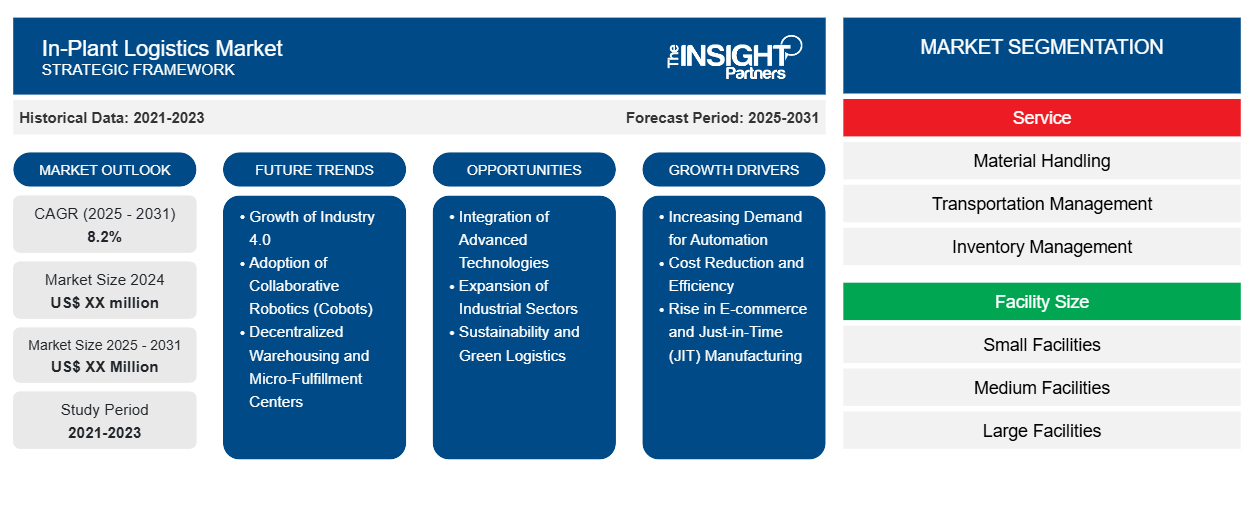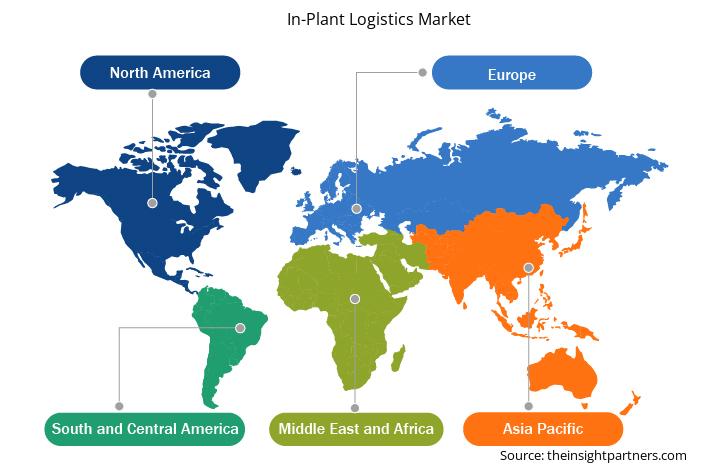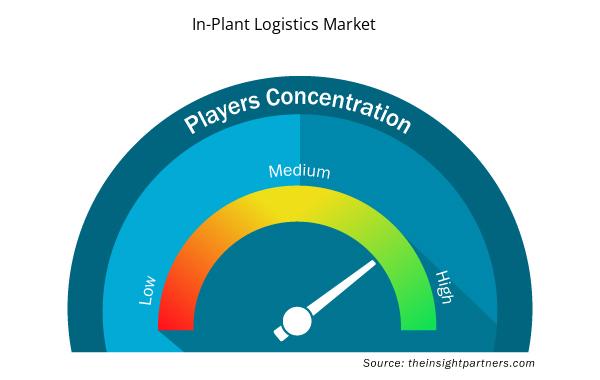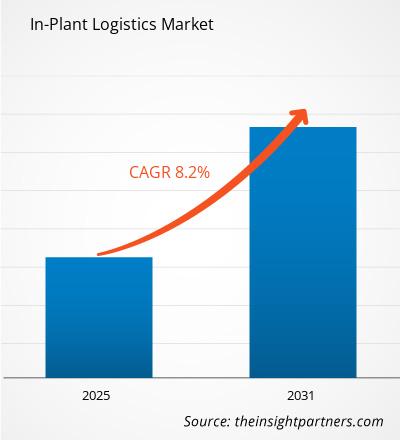工場内物流市場は、2025年から2031年にかけて8.2%のCAGRで成長すると予想されており、市場規模は2024年のXX百万米ドルから2031年にはXX百万米ドルに拡大すると予想されています。
レポートは、サービス(マテリアルハンドリング、輸送管理、在庫管理、梱包とラベル付け、その他)、施設規模(小規模施設、中規模施設、大規模施設)、エンドユーザー(エレクトロニクス、食品と飲料、自動車、航空宇宙と防衛、化学、その他)別にセグメント化されています。グローバル分析は、地域レベルと主要国でさらに細分化されています。レポートは、上記の分析とセグメントに対して米ドルでの価値を提供します。
報告書の目的
The Insight Partners のレポート「In-Plant Logistics Market」は、現在の状況と将来の成長、主な推進要因、課題、機会を説明することを目的としています。これにより、次のようなさまざまなビジネス関係者に洞察が提供されます。
- テクノロジープロバイダー/メーカー: 進化する市場の動向を理解し、潜在的な成長機会を把握することで、情報に基づいた戦略的意思決定が可能になります。
- 投資家: 市場の成長率、市場の財務予測、バリュー チェーン全体に存在する機会に関する包括的な傾向分析を実施します。
- 規制機関: 市場の濫用を最小限に抑え、投資家の信用と信頼を維持し、市場の完全性と安定性を維持することを目的として、市場における政策と警察活動を規制します。
工場内物流市場のセグメンテーション
サービス
- マテリアルハンドリング
- 輸送管理
- 在庫管理
- 包装とラベル
施設規模
- 小規模施設
- 中規模施設
- 大規模施設
エンドユーザー
- エレクトロニクス
- 食品・飲料
- 自動車
- 航空宇宙および防衛
- 化学薬品
地理
- 北米
- ヨーロッパ
- アジア太平洋
- 中東およびアフリカ
- 南米と中央アメリカ
要件に合わせてレポートをカスタマイズする
このレポートの一部、国レベルの分析、Excelデータパックなど、あらゆるレポートを無料でカスタマイズできます。また、スタートアップや大学向けのお得なオファーや割引もご利用いただけます。
工場内物流市場:戦略的洞察

- このレポートの主要な市場動向を入手してください。この無料サンプルには、市場動向から見積もりや予測に至るまでのデータ分析が含まれます。
工場内物流市場の成長要因
- 自動化の需要の高まり: 製造プロセスにおける自動化のニーズの高まりは、工場内物流市場の大きな推進力となっています。企業が生産効率を最適化し、人的ミスを削減することを目指す中、無人搬送車 (AGV)、ロボットによるプロセス自動化、倉庫管理システム (WMS) などの自動化ソリューションが重要になっています。これらのテクノロジーは、資材の取り扱いを合理化し、全体的な生産性を向上させるため、工場内物流ソリューションの採用につながっています。
- コスト削減と効率: 企業は、効率性を高めながら運用コストを削減するというプレッシャーに常にさらされています。工場内物流は、製造工場内の材料の流れ、在庫管理、サプライ チェーン プロセスを最適化する上で重要な役割を果たします。工場内物流は、無駄を減らし、部品をタイムリーに納品し、人件費を最小限に抑えることで、メーカーが大幅な節約を実現するのに役立ちます。
- 電子商取引とジャストインタイム (JIT) 製造の増加: 電子商取引の急増と JIT 製造モデルの採用により、正確で効率的な物流が重視されるようになりました。工場内物流は、ターンアラウンド タイムの短縮、在庫管理の改善、サプライヤーから生産ラインへの商品のシームレスな流れを可能にします。より迅速で信頼性の高い配送システムに対する需要が、工場内物流の成長を促しました。
工場内物流市場の将来動向
- インダストリー 4.0 の成長: サイバー フィジカル システム、クラウド コンピューティング、デジタル ツインの統合を含むインダストリー 4.0 によって推進される継続的な変革により、工場内物流市場が再編されることになります。相互接続されたマシン、システム、センサーの使用が増えると、データ収集が向上し、プロセス自動化が進み、物流モデルが予測しやすくなります。この傾向により、意思決定が強化され、サプライ チェーンが最適化され、工場内物流業務がよりスマートになります。
- 協働ロボット (コボット) の導入: 工場内物流の将来では、人間の作業員と一緒に作業する協働ロボット (コボット) の導入が進むでしょう。これらのロボットは、材料処理、在庫管理、梱包などの作業を実行するように設計されており、工場内の安全性と効率性を向上させます。コボットは作業員の負担を軽減し、重労働の反復作業の処理を支援し、より機敏な物流業務を可能にします。
- 分散型倉庫とマイクロフルフィルメントセンター: サプライチェーンが複雑化し、顧客がより迅速な配送を求めるようになると、工場内物流の将来には分散型倉庫戦略が含まれるようになります。企業は、生産施設や都市部に近い場所にマイクロフルフィルメントセンターを設置する可能性が高く、これにより製品のより迅速かつ効率的な配送が可能になります。この傾向は、オンデマンド生産とジャストインタイム配送モデルへの移行と一致しています。
工場内物流の市場機会
- 先進技術の統合: 人工知能 (AI)、機械学習、モノのインターネット (IoT)、ビッグデータ分析の進歩により、工場内物流市場は成長の態勢が整っています。これらの技術により、リアルタイムの追跡、予知保全、需要予測が可能になり、企業は業務を最適化し、意思決定を改善する機会を得ることができます。これらの技術を物流業務に統合することに投資する企業は、競争上の優位性を獲得する立場にあります。
- 産業分野の拡大: 自動車、医薬品、化学薬品、家電製品など、さまざまな産業の継続的な拡大により、工場内物流プロバイダーにチャンスが生まれています。これらの産業が消費者の需要増大に対応するために生産を拡大するにつれ、高度でスケーラブルな物流ソリューションの必要性がますます高まっています。この傾向により、産業プラント内の物流サービスの市場が活性化し、新たなパートナーシップやビジネスチャンスが生まれています。
- 持続可能性とグリーン物流: 持続可能性が世界的に優先課題となるにつれ、工場内物流プロバイダーが環境に優しいソリューションを提供する機会が増えています。サプライチェーンのプロセスを最適化し、二酸化炭素排出量を削減し、グリーンテクノロジーを採用することで、企業は環境への影響を軽減できます。これには、電気自動車、エネルギー効率の高い倉庫、持続可能な梱包ソリューションの使用が含まれ、消費者と規制機関の両方からますます求められています。
工場内物流市場の地域別分析
予測期間を通じて工場内物流市場に影響を与える地域的な傾向と要因は、Insight Partners のアナリストによって徹底的に説明されています。このセクションでは、北米、ヨーロッパ、アジア太平洋、中東、アフリカ、南米、中米にわたる工場内物流市場のセグメントと地理についても説明します。

- 工場内物流市場の地域別データを入手
工場内物流市場レポートの範囲
| レポート属性 | 詳細 |
|---|---|
| 2024年の市場規模 | XX百万米ドル |
| 2031年までの市場規模 | XX百万米ドル |
| 世界のCAGR(2025年~2031年) | 8.2% |
| 履歴データ | 2021-2023 |
| 予測期間 | 2025-2031 |
| 対象セグメント | サービス別
|
| 対象地域と国 | 北米
|
| 市場リーダーと主要企業プロフィール |
|
工場内物流市場のプレーヤー密度:ビジネスダイナミクスへの影響を理解する
工場内物流市場は、消費者の嗜好の変化、技術の進歩、製品の利点に対する認識の高まりなどの要因により、エンドユーザーの需要が高まり、急速に成長しています。需要が高まるにつれて、企業は提供内容を拡大し、消費者のニーズを満たすために革新し、新たなトレンドを活用し、市場の成長をさらに促進しています。
市場プレーヤー密度とは、特定の市場または業界内で活動している企業または会社の分布を指します。これは、特定の市場スペースに、その市場規模または総市場価値に対してどれだけの競合相手 (市場プレーヤー) が存在するかを示します。
工場内物流市場で事業を展開している主要企業は次のとおりです。
- KIONグループ
- トヨタマテリアルハンドリング
- 三菱ロジスネクスト
- ユンハインリッヒAG
- SSIシェーファー
- ハネウェル・インテリグレーテッド
免責事項:上記の企業は、特定の順序でランク付けされていません。

- 工場内物流市場のトップキープレーヤーの概要を入手
主なセールスポイント
- 包括的なカバレッジ: レポートでは、プラント内物流市場の製品、サービス、タイプ、エンドユーザーの分析を包括的にカバーし、全体的な展望を提供します。
- 専門家による分析: レポートは、業界の専門家とアナリストの深い理解に基づいてまとめられています。
- 最新情報: このレポートは、最新の情報とデータの傾向を網羅しているため、ビジネスの関連性を保証します。
- カスタマイズ オプション: このレポートは、特定のクライアント要件に対応し、ビジネス戦略に適切に適合するようにカスタマイズできます。
したがって、プラント内物流市場に関する調査レポートは、業界のシナリオと成長の見通しを解読し理解する道の先導役となることができます。正当な懸念事項がいくつかあるかもしれませんが、このレポートの全体的な利点は欠点を上回る傾向があります。
- 過去2年間の分析、基準年、CAGRによる予測(7年間)
- PEST分析とSWOT分析
- 市場規模価値/数量 - 世界、地域、国
- 業界と競争環境
- Excel データセット



Report Coverage
Revenue forecast, Company Analysis, Industry landscape, Growth factors, and Trends

Segment Covered
This text is related
to segments covered.

Regional Scope
North America, Europe, Asia Pacific, Middle East & Africa, South & Central America

Country Scope
This text is related
to country scope.
よくある質問
Some of the customization options available based on the request are an additional 3–5 company profiles and country-specific analysis of 3–5 countries of your choice. Customizations are to be requested/discussed before making final order confirmation as our team would review the same and check the feasibility
The report can be delivered in PDF/PPT format; we can also share excel dataset based on the request
Adoption of Collaborative Robotics (Cobots) is anticipated to play a significant role in the global in-plant logistics market in the coming years
The major factors driving the in-plant logistics market are:
1. Increasing Demand for Automation
2. Rise in E-commerce and Just-in-Time (JIT) Manufacturing
The global in-plant logistics market is expected to grow at a CAGR of 8.2% during the forecast period 2024 - 2031
Trends and growth analysis reports related to Automotive and Transportation : READ MORE..
The Insight Partners performs research in 4 major stages: Data Collection & Secondary Research, Primary Research, Data Analysis and Data Triangulation & Final Review.
- Data Collection and Secondary Research:
As a market research and consulting firm operating from a decade, we have published and advised several client across the globe. First step for any study will start with an assessment of currently available data and insights from existing reports. Further, historical and current market information is collected from Investor Presentations, Annual Reports, SEC Filings, etc., and other information related to company’s performance and market positioning are gathered from Paid Databases (Factiva, Hoovers, and Reuters) and various other publications available in public domain.
Several associations trade associates, technical forums, institutes, societies and organization are accessed to gain technical as well as market related insights through their publications such as research papers, blogs and press releases related to the studies are referred to get cues about the market. Further, white papers, journals, magazines, and other news articles published in last 3 years are scrutinized and analyzed to understand the current market trends.
- Primary Research:
The primarily interview analysis comprise of data obtained from industry participants interview and answers to survey questions gathered by in-house primary team.
For primary research, interviews are conducted with industry experts/CEOs/Marketing Managers/VPs/Subject Matter Experts from both demand and supply side to get a 360-degree view of the market. The primary team conducts several interviews based on the complexity of the markets to understand the various market trends and dynamics which makes research more credible and precise.
A typical research interview fulfils the following functions:
- Provides first-hand information on the market size, market trends, growth trends, competitive landscape, and outlook
- Validates and strengthens in-house secondary research findings
- Develops the analysis team’s expertise and market understanding
Primary research involves email interactions and telephone interviews for each market, category, segment, and sub-segment across geographies. The participants who typically take part in such a process include, but are not limited to:
- Industry participants: VPs, business development managers, market intelligence managers and national sales managers
- Outside experts: Valuation experts, research analysts and key opinion leaders specializing in the electronics and semiconductor industry.
Below is the breakup of our primary respondents by company, designation, and region:

Once we receive the confirmation from primary research sources or primary respondents, we finalize the base year market estimation and forecast the data as per the macroeconomic and microeconomic factors assessed during data collection.
- Data Analysis:
Once data is validated through both secondary as well as primary respondents, we finalize the market estimations by hypothesis formulation and factor analysis at regional and country level.
- Macro-Economic Factor Analysis:
We analyse macroeconomic indicators such the gross domestic product (GDP), increase in the demand for goods and services across industries, technological advancement, regional economic growth, governmental policies, the influence of COVID-19, PEST analysis, and other aspects. This analysis aids in setting benchmarks for various nations/regions and approximating market splits. Additionally, the general trend of the aforementioned components aid in determining the market's development possibilities.
- Country Level Data:
Various factors that are especially aligned to the country are taken into account to determine the market size for a certain area and country, including the presence of vendors, such as headquarters and offices, the country's GDP, demand patterns, and industry growth. To comprehend the market dynamics for the nation, a number of growth variables, inhibitors, application areas, and current market trends are researched. The aforementioned elements aid in determining the country's overall market's growth potential.
- Company Profile:
The “Table of Contents” is formulated by listing and analyzing more than 25 - 30 companies operating in the market ecosystem across geographies. However, we profile only 10 companies as a standard practice in our syndicate reports. These 10 companies comprise leading, emerging, and regional players. Nonetheless, our analysis is not restricted to the 10 listed companies, we also analyze other companies present in the market to develop a holistic view and understand the prevailing trends. The “Company Profiles” section in the report covers key facts, business description, products & services, financial information, SWOT analysis, and key developments. The financial information presented is extracted from the annual reports and official documents of the publicly listed companies. Upon collecting the information for the sections of respective companies, we verify them via various primary sources and then compile the data in respective company profiles. The company level information helps us in deriving the base number as well as in forecasting the market size.
- Developing Base Number:
Aggregation of sales statistics (2020-2022) and macro-economic factor, and other secondary and primary research insights are utilized to arrive at base number and related market shares for 2022. The data gaps are identified in this step and relevant market data is analyzed, collected from paid primary interviews or databases. On finalizing the base year market size, forecasts are developed on the basis of macro-economic, industry and market growth factors and company level analysis.
- Data Triangulation and Final Review:
The market findings and base year market size calculations are validated from supply as well as demand side. Demand side validations are based on macro-economic factor analysis and benchmarks for respective regions and countries. In case of supply side validations, revenues of major companies are estimated (in case not available) based on industry benchmark, approximate number of employees, product portfolio, and primary interviews revenues are gathered. Further revenue from target product/service segment is assessed to avoid overshooting of market statistics. In case of heavy deviations between supply and demand side values, all thes steps are repeated to achieve synchronization.
We follow an iterative model, wherein we share our research findings with Subject Matter Experts (SME’s) and Key Opinion Leaders (KOLs) until consensus view of the market is not formulated – this model negates any drastic deviation in the opinions of experts. Only validated and universally acceptable research findings are quoted in our reports.
We have important check points that we use to validate our research findings – which we call – data triangulation, where we validate the information, we generate from secondary sources with primary interviews and then we re-validate with our internal data bases and Subject matter experts. This comprehensive model enables us to deliver high quality, reliable data in shortest possible time.

 このレポートの無料サンプルを入手する
このレポートの無料サンプルを入手する